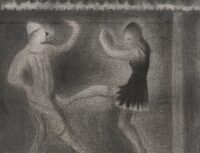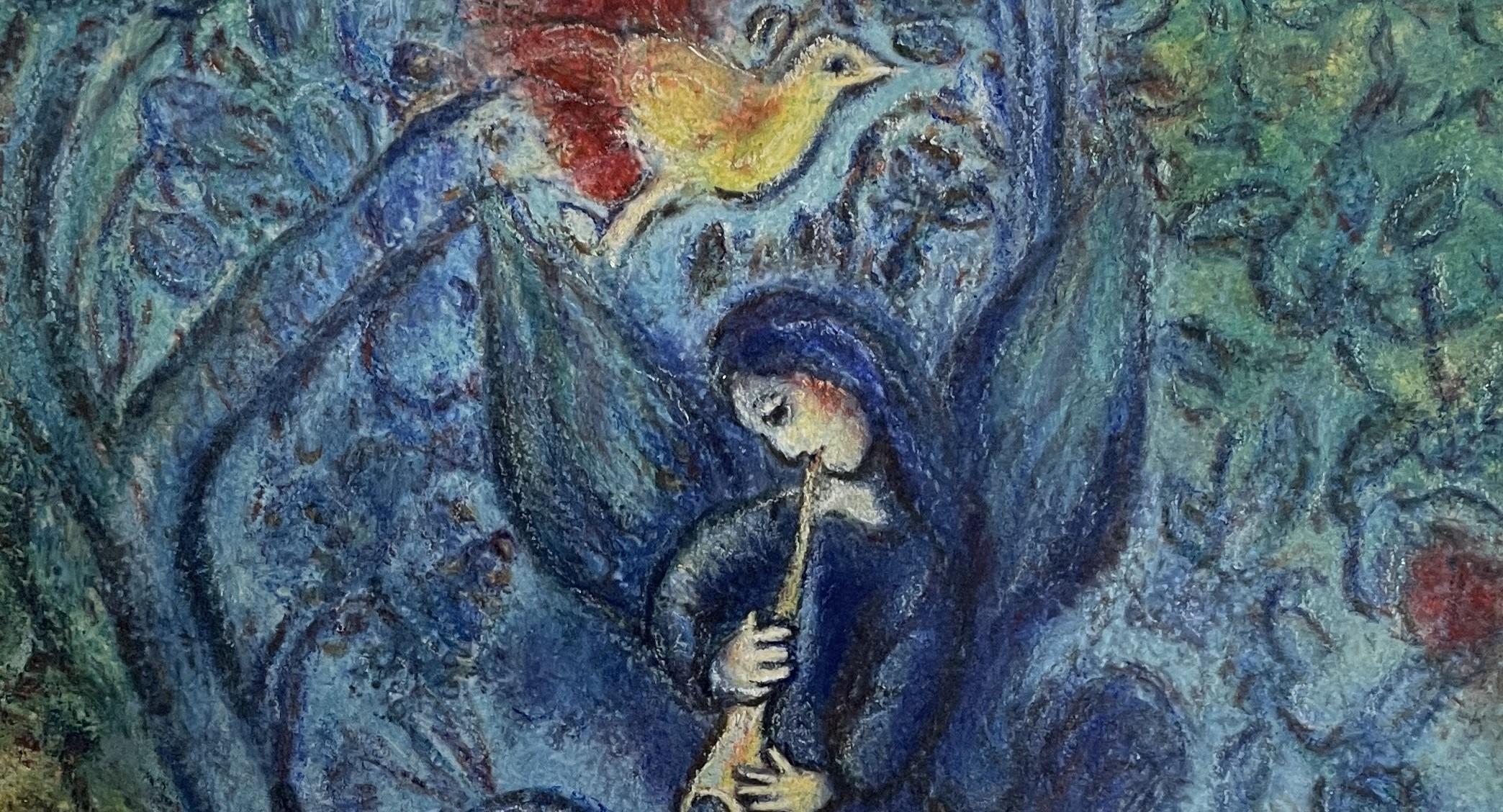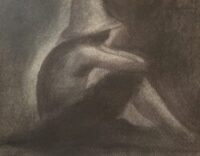日本語-Englishー台灣華語
ジョルジュ・スーラ「トロンボーン奏者」
その時私は、とある上場企業の買収可能性調査を依頼され、密かに調査を進めていたのだが、「買収をとりやめにしたい」と突然連絡があり話は露と消えてしまった。依頼主は親しい方だったので、私は気にとめていなかったが、その方は「私がスーラのデッサンをいずれ手に入れたいものです」と以前話をしたことがあるのを覚えていて、自分からお願いした話を取りやめにしたのは心苦しいからと、秘蔵するスーラのデッサンを譲って下さった。それはスーラが1880年頃に描いた「女のデッサン」という作品であった。この作品はスーラのカタログレゾネⅡに395番として掲載されているポール・シニャック旧蔵のデッサンである。
1879年の第四回印象派展に感銘を受け、美術学校をやめることを決意し、ドラクロワの技術研究や色彩研究を試みている時期に描かれた作品である。 スーラはパリの裕福な家庭に1859年に生まれている。父親は官吏を退官し年金で田舎暮らしを好んだという。そのためスーラは主に母親の手で育てられた。そう言えばこのデッサンは母親を描いたもののように思える。スーラは16歳でパリ市立デッサン学校に入り、その後1878年にはパリの名門美術学校エコール・デ・ボザール(パリ国立高等美術学校)に入学しアンリ・レーマンに師事した。レーマンはアングルの弟子で、スーラは徹底的に古典主義技法を教え込まれた。スーラ自身も、当初はその伝統的アカデミズムの画風を好んだと言われている。このデッサンには古典主義的な匂いが色濃く残っているが、形を追うのではなく、形のとらえ方に意が払われており、スーラ自身が懸命に独自の様式を探し求めていた片鱗がある。このデッサンを見ていると、明暗の調子で実在感を伝えようとする様式を次第に確立しつつあったことが伺える。
美術評論家のフェリックス・フェネオは、スーラやシニャックの表現様式を新印象主義と呼んだ。スーラはミシェル=ウジェーヌ・シュヴルールやシャルル・アンリの光学理論や色彩論の影響を受け、科学的絵画手法を模索した。彼らは光輝く鮮やかな絵を実現するために、パレットの上での混色を避け、画面に直接点で描き、視覚によって混合する分割主義の考えを導入した。スーラの凄みは、科学的手法論を用いながら、画面には清楚で抒情的な雰囲気が漂っていることである。そこには調和のとれた気品がある。シニャックはそれを「詩的」という言葉を使って表現している。 スーラは1883年に2点のデッサンをサロンに出品し、そのうちの1点で初入選を果たす。その後有名な作品の一つである「アニエールの水浴」の制作を始める。1885年にはかの有名な作品「グランド・ジャット島の日曜日の午後」の制作を始めるが、点描は極度の疲労を伴う作業なのか、1891年には過労から風邪をこじらせて髄膜炎となり、偉大な才能を有しながら31歳の若さでこの世を去ってしまう。
デッサンは画家の言葉である。対象を凝視しながらも、記憶によって描いたスーラのデッサンには画家の並々ならぬ力量が見て取れる。闇の中から姿を現わしながら、半ば闇に溶解するスーラ独特のデッサンは、途方もない値段になってしまったが、それだけの価値がある。
私は思いがけず手に入った「女のデッサン」を眺めながら、「トロンボーン奏者」を描くことにした。この作品は油彩の大作「サーカスのパレード」のための習作として描かれたものである。トロンボーン奏者と舞台の様子が黒の諧調で慎重に描き分けられ白い光に照らされている。スーラのデッサンには輪郭線がない。私はとても濃い鉛筆を使ってトロンボーン奏者と人物をまず描いてから、その間を少しずつ濃度の異なる鉛筆に持ち替えながら描いてゆく。スーラのデッサンは細心の注意を払いながらも、ランダムな霧のようなタッチで描かれ縦横に網状の陰影がつけられている。スーラの油彩は点描であるため色彩理論に意識が偏りがちであるが、単なる同じ色の点で描かれているのではない。微妙に調整された色彩の推移によって描かれているのが重要なのだ。その土台にあるのが、黒一色で描かれたデッサンの諧調にあることを私は気づかされる。

Pierrot and Colombine
皮耶羅與哥倫比娜
Trombonist
At that time, I was secretly conducting a feasibility study for the acquisition of a certain listed company after being requested to do so, but suddenly received a message saying, “I want to cancel the acquisition,” and just like that, the discussion vanished into thin air. The client was someone close to me, so I wasn’t particularly bothered, but they remembered that I had once mentioned wanting to acquire a drawing by Seurat and felt guilty for withdrawing the request they had made themselves, and thus offered to give me a cherished Seurat drawing. It was a work titled “Drawing of a Woman” that Seurat had created around 1880. This piece is listed as number 395 in Seurat’s Catalogue Raisonné II, formerly in the collection of Paul Signac. It was drawn during a period when Seurat, inspired by the fourth Impressionist exhibition in 1879 and having decided to leave art school, was experimenting with studies of technique and color.
Seurat was born into a wealthy family in Paris in 1859. His father had retired from a civil service position and preferred living in the countryside on his pension. As a result, Seurat was raised primarily by his mother. Now that I think about it, this drawing seems to depict his mother. Seurat entered the Municipal School of Drawing in Paris at the age of 16 and later, in 1878, enrolled in the prestigious École des Beaux-Arts in Paris, where he studied under Henri Lehmann. Lehmann, a disciple of Ingres, rigorously taught Seurat the techniques of classical art. Seurat himself was said to have initially favored this traditional academic style. The drawing retains a strong classical aura, but rather than pursuing form, it focuses on the way form is perceived, showing Seurat’s earnest search for a unique style. Looking at this drawing, one can sense he was gradually establishing a style aimed at conveying a sense of reality through light and shadow.
Art critic Félix Fénéon termed the expressive styles of Seurat and Signac as Neo-Impressionism. Influenced by the optical theories and color theories of Michel-Eugène Chevreul and Charles Henry, Seurat explored scientific painting methods. They introduced the idea of Divisionism, avoiding mixing colors on the palette and instead applying paint in dots directly on the canvas, allowing for visual mixing. Seurat’s brilliance lay in using scientific methodologies while maintaining a clean, lyrical atmosphere in his paintings, characterized by a harmonious elegance. Signac described it as “poetic.”
Seurat exhibited two drawings at the Salon in 1883, earning his first selection with one of them. He then began working on one of his most famous works, “Bathers at Asnières.” In 1885, he started creating the renowned “A Sunday Afternoon on the Island of La Grande Jatte.” The pointillist technique was so labor-intensive that he succumbed to exhaustion, leading to a fatal case of meningitis in 1891, cutting short the life of this immensely talented artist at the age of 31.
A drawing is a painter’s language. Seurat’s drawings, created from memory while intensely observing his subjects, reveal an extraordinary artistic power. Emerging from the darkness, partially dissolving back into it, Seurat’s unique style of drawing has become incredibly valuable, justifiably so. Unexpectedly acquiring the “Drawing of a Woman,” I decided to create a depiction of a “Trombone Player.” This was a study for a major oil painting titled “The Circus Parade.” The trombone player and the stage setting are carefully differentiated through shades of black, illuminated by white light. Seurat’s drawings lack contour lines. I began by drawing the trombone player and figures with a very dark pencil, gradually switching to pencils of different densities. Despite careful attention, Seurat’s drawings are rendered with a random, mist-like touch, creating a mesh of shadows across the surface. While Seurat’s oil paintings are known for pointillism, focusing heavily on color theory, they are not merely composed of dots of the same color. The subtlety of the color transitions, based on the tonal harmony of the black-and-white drawings, is crucial. This realization highlighted the importance of the tonal harmony found in the black-and-white drawings as the foundation.
喬治·修拉「長號演奏家」
那時候,我被委託調查一家上市公司的收購可能性,正秘密進行調查時,突然接到「想要取消收購」的聯繫,使得整個案件就此煙消雲散。委託人是我親近的人,我並未放在心上,但該人記得我之前曾說過想要某天能夠得到蘇拉的素描,因為覺得取消自己提出的請求讓人感到不安,於是就將珍藏的蘇拉素描送給了我。那是蘇拉在1880年左右繪製的「女性的素描」,這幅作品是保羅·西尼亞克舊藏,收錄於蘇拉的作品目錄卷二,編號395。在受到1879年第四屆印象派展覽的啟發後,他決定離開美術學校,並嘗試進行德拉克羅瓦的技術研究和色彩研究,這幅作品正是在那時期繪製的。
蘇拉於1859年出生於巴黎一個富裕的家庭,父親是一名退休的官員,喜歡鄉村生活。因此,蘇拉主要是由母親撫養長大的。說起來,這幅素描似乎是畫的他的母親。蘇拉16歲時進入巴黎市立繪畫學校,後於1878年進入巴黎的名校國立高等美術學院(Ecole des Beaux-Arts),師從亨利·雷曼。雷曼是安格爾的學生,蘇拉被徹底灌輸古典主義技法。蘇拉本人最初也偏好傳統的學院派風格。這幅素描濃厚地保留了古典主義的氣息,但不是追求形式,而是注重形式的捕捉方式,可以看出蘇拉努力尋求自己獨特風格的跡象。從這幅素描中,可以逐漸感受到他在逐步確立用明暗調來傳達實感的風格。
美術評論家菲利克斯·費內翁將蘇拉和西尼亞克的表現風格稱為新印象主義。蘇拉受到米歇爾-尤金·雪佛勒和夏爾·亨利的光學理論和色彩論影響,探索科學的繪畫手法。他們為了實現閃耀的鮮豔畫面,避免在調色盤上混色,而是直接在畫布上以點狀繪製,通過視覺混合的分割主義理念。蘇拉的偉大之處在於,雖然使用科學的方法論,畫面卻散發著清新和抒情的氛圍,其中有一種和諧的高貴感。西尼亞克用「詩意」一詞來表達這種風格。
蘇拉1883年曾將兩幅素描作品提交薩龍展覽,其中一幅獲得了首次入選。之後,他開始創作其中一件著名作品「安尼耶河畔的浴場」。1885年,他開始創作另一件著名作品「大碗島上的星期日下午」,點描是一項極度耗費體力的工作,1891年,他因過度勞累引發感冒,最終導致腦膜炎,年僅31歲便離世。
素描是畫家的語言。蘇拉的素描,即使是凝視著對象,也是依靠記憶繪製的,展現了畫家非凡的力量。從黑暗中顯現的形象,半隱於黑暗中的蘇拉獨特的素描風格,價值連城。我意外獲得的「女性的素描」讓我決定繪製「長號演奏家」。這幅作品是為大型油畫「馬戲團遊行」的習作而繪製的,長號演奏家和舞台場景以黑色的調子謹慎分離,並被白光照亮。蘇拉的素描沒有輪廓線。我首先使用非常深的鉛筆描繪長號演奏家和人物,然後逐漸換成不同深淺的鉛筆進行繪製。蘇拉的素描雖然細膩,但以隨機的霧狀觸感描繪,並在其中加入了縱橫交錯的陰影。由於蘇拉的油畫是點描,所以在色彩理論上可能會有所偏重,但並非僅僅用相同顏色的點繪製。重要的是,它是通過細膩調整色彩過渡來繪製的。我意識到這一切的基礎,正是建立在黑色一色繪製的素描調子上。



